Junior Johnson is frequently cited as the fellow who said that if you want to make a small fortune in racing, start with a large one. Big-time racing has always been a money thing. Thanks to the power of the internet, one of us has the opportunity to have fun and go broke in vintage racing. Take a look at this 1963 Corvette convertible for sale on eBay in Longview, Texas. This legit vintage race car comes with photo documentation and an SCCA logbook from back in the day. With a current bid of $11,600, could this Corvette be a gateway drug to both racing fun and financial ruin?
In our current reality, race tracks are closing all over the United States. From dragstrips to the half-mile bull rings all the way up to road courses, the spread of suburbia, insurance rates, and the small but annoyingly vocal and effective Not In My Back Yard contingent have all worked hand in hand to destroy this once wholesome pastime. Any look at books or websites documenting the glory days of racing will sadden you with the names of tracks come and gone. We are not living in the best of times for grassroots motorsports.
That doesn’t mean that fun isn’t still out there for the enterprising. Vintage racing has become quite popular worldwide, and organizations like the Sportscar Vintage Racing Association, the Vintage Sports Car Club of America and other groups are very actively involved in sanctioning races and growing this subsection of racing. If you have a legitimate vintage race car with all the required safety items, money, and desire, you can go racing at some of America’s most famous tracks.
So, how does one get on the track? First, with the help of someone knowledgeable, learn the ins and outs of vintage motorsports as it relates to you being a participant rather than a spectator. The next step would be to attend an event or two to get a feel for how things run and what you will need. Ask questions of race officials, owners, drivers, and anyone else who may expand your knowledge. From there, you may want to contact one of the various businesses that provide instruction on how to race. Go to one of the classes they offer to learn the safe way to race. This is not the road. There are rules.
Once you have decided that racing is for you, take a vow of poverty and find yourself a race car like this 1963 Corvette. Some may argue that you should start out vintage racing with something smaller and slower. Racing an Austin Healey Sprite, an MGB, or a Spitfire could be a lot of fun and a good way to get your feet wet. However, a lot of the fixed infrastructure costs like a tow vehicle, a trailer, tools, spares, safety equipment, and all the other things you need will cost the same amount. Why not start with a car that will retain its value and is built with readily available parts? The drivetrain of a mid-year Corvette contains some of the most commonly found parts in racing.
This Corvette has a logbook documented history of running SCCA B Production races. It campaigned at the NE Ohio Regionals, OVR Regional at Mid Ohio, and other famous SCCA events of the time. After the racing was over in the eighties, this Corvette went into storage. The seller is upfront in telling us that the seventies Corvette 350 cubic inch engine and four-speed will need to be rebuilt. The frame and body, complete with a 1967 front clip, are described as solid. However, the seller clearly states that the car as a whole is in need of restoration. It does come with a racing instrument cluster, headlight buckets for the same purpose, and a 1983 title in the prior owner’s name. The way the ad reads leads one to believe that the car will not come with a title.
Regardless of that statement, it does have the original VIN and trim tags in place. These are simply riveted on and quite simple in construction. Still, that is all you need in many states to apply for a title if you were so inclined. Many feel that a title on a race car is of little value. Perhaps not for some disposable econobox you are trying to run in street stock at the local dirt track. For a vintage race car of some value, I am unsure as to how proving ownership works. If there are any racers who can enlighten us, please do so in the comments.
The pictures of this car back then that the seller kindly provided in the ad are a fascinating glimpse back to a different time. Most vintage race car events today feature cars brought in with anything from an open trailer like you see above to a full-on race hauler that would do a NASCAR team proud. This car could be a lot of fun for a relatively small investment compared to other vehicles in its class. Hopefully we will see it back on the track soon, maybe even in that Dukes of Hazzard orange finish in the pictures below. I’d get a taller roll bar setup though.
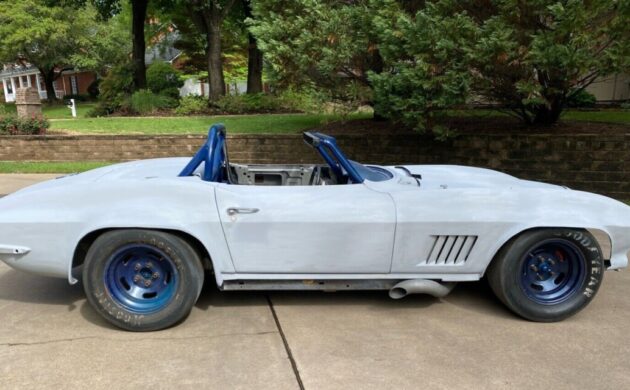
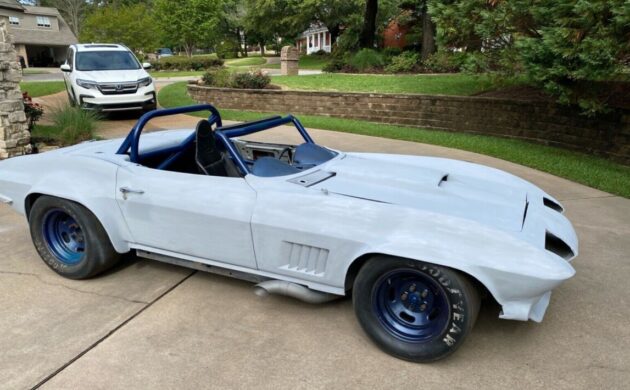
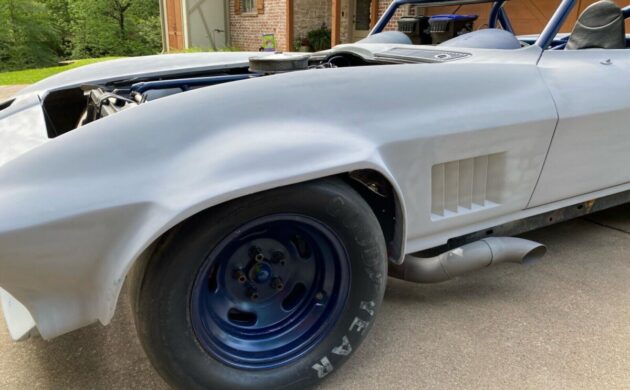
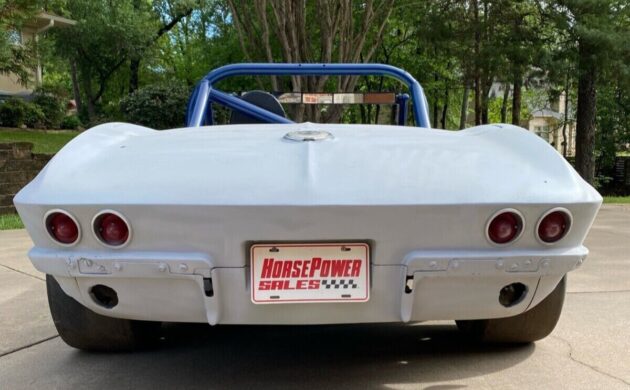
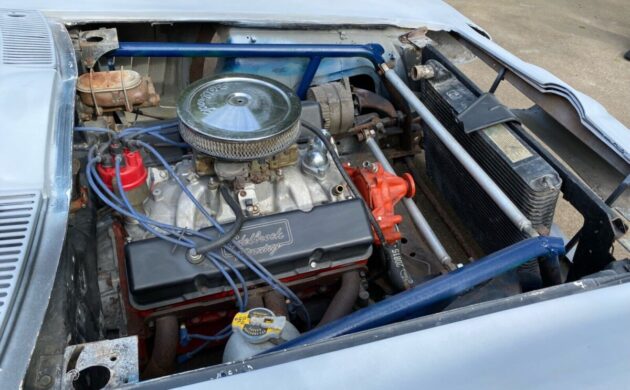
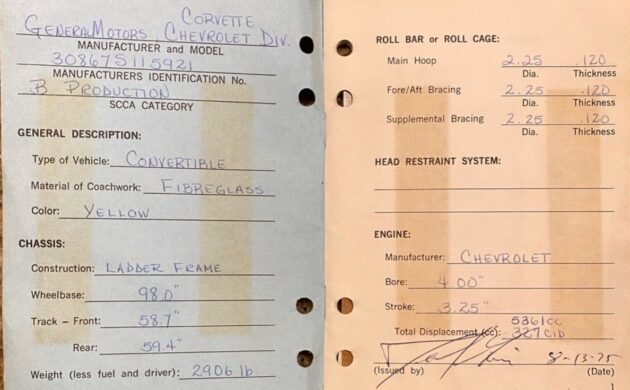

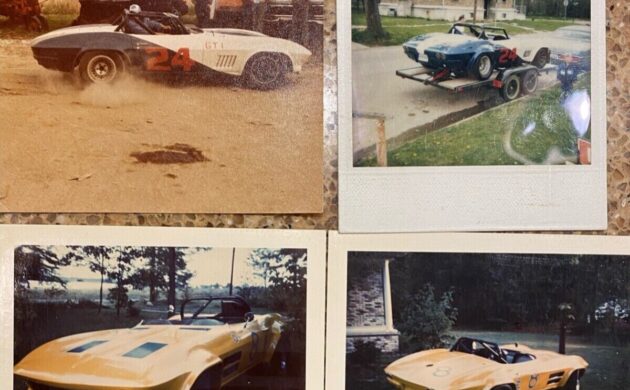


Nice write up Jeff. Your comment about raising the roll bar after looking at the earlier pictures was a great idea but the present pictures and the early yellow shot in the lower left corner shows that the hoop was raised, probably to meet the new SCCA rules that the bar had to be 2 inches above the driver’s helmet. Also notice that the car’s class changed from B Production to GT 1 which happened in the late 70’s. That put it in the class with the big V8 cars and exists today. It also put cars like our ’59 Porsche Convertible D into B Production as the 1600 cc cars like the MGBs became more popular race cars. Our present Sprite HP car is is at a disadvantage now that they put larger engine cars into the class like the VWs with the 1600 and up cc engines. No substitute for more horsepower. That said, we’re going to sell our present H Production car and are building a Sprite Vintage car to go racing for fun instead of trophies. Vintage should be a good home for this Corvette.
That’s a mighty bold statement not street legal, until a set of Whelan strobes are behind you everything is street legal
NIIBY’s are worse and are now BANANA’s; Build Absolutely Nothing Anywhere Near Anything’s.
Unless the side panels were changed, the white Vette is a ’67…look at all the fins. Only ’67 had that many in the C2 series.
That’s a common modification. Look at the VIN.